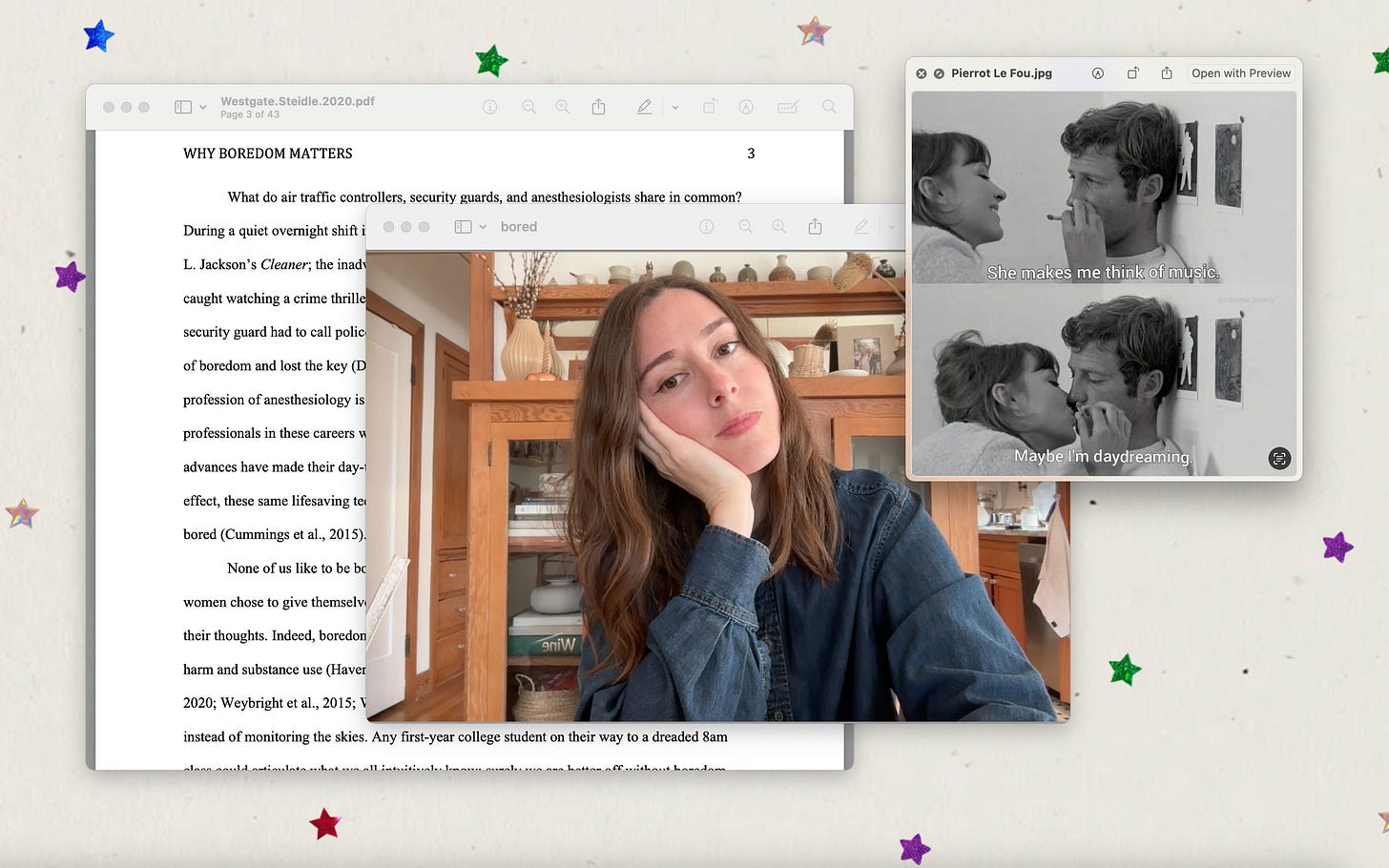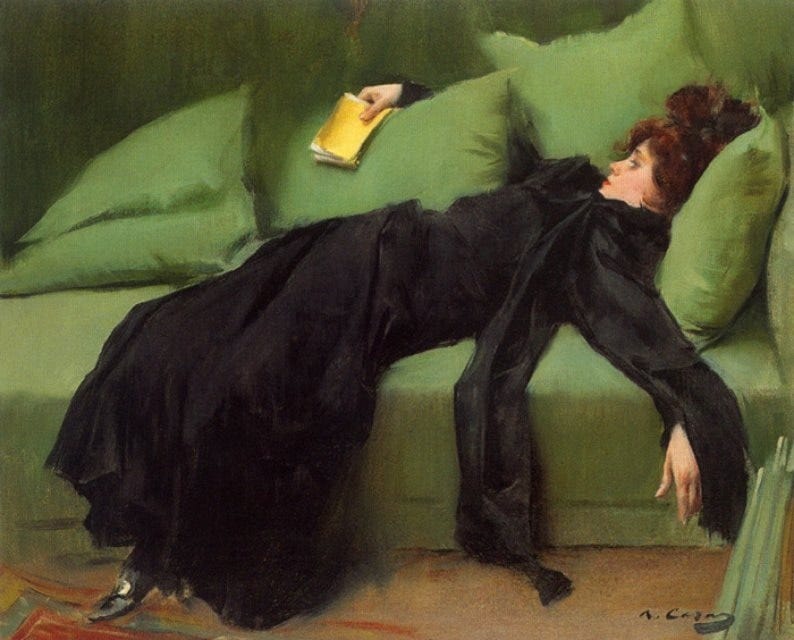I don’t remember the last time I was bored.
Not aimlessly swiping through Instagram or TikTok bored, but the kind of quiet, spacious boredom that used to creep in while waiting in line, on afternoons during summer break at home when all of my friends were busy, or in moments before social media existed. Lately, I’ve been wondering what we’ve lost in our (sometimes unconscious) quest to eliminate that feeling. In a world designed to keep our attention at all times, boredom has become something to avoid at all costs. But what if that spacious boredom is a better choice than picking up our phones to numb out?
We’re constantly stimulated and entertained, yet there is research that shows that even though we do not experience the type of spacious boredom I named above, our feelings of boredom have statistically increased from 2010 to 2017. The prevalence of boredom is actually on the rise, which may be due to technological advances that separate us from sources of meaning (relationships, meaningful work, stable routines, and communities). (Danckert & Merrifield, 2016, Twenge et al., 2018)
People often equate boredom with having nothing to do, but we currently ALWAYS have something to do, and yet we find ourselves feeling bored and empty.
We will do anything to avoid being alone with ourselves and our negative emotions, and our phones have made it possible. We dislike being bored so much that in one study, people chose to give themselves an electric shock rather than be bored while sitting alone with their thoughts for 6-15 minutes. 67% of men and 25% of women chose to shock themselves at least once, even though they had previously said they would pay money to avoid it. (Wilson et al., 2014)
When we’ll do anything to avoid negative emotions, we’re also keeping ourselves from noticing and feeling positive emotions, too. Now we’re understimulated or overstimulated, with nowhere in between.
So, what is boredom exactly?
We often treat boredom like a problem to fix or escape, but boredom isn’t just a lack of stimulation or “having nothing to do.” Psychologist Erin Westgate describes it as a kind of emotional signal, alerting us that our current activity is no longer satisfying or meaningful. It’s not that we have nothing to do, it’s that we have nothing we want to do. Or nothing that feels worth our time and attention.
According to the MAC model (Meaning and Attention Components), boredom can show up when we’re either under-stimulated (think long, repetitive meetings) or over-stimulated, like when we’re scrolling social media and suddenly everything feels dull. In both cases, boredom is what we feel when our mind is craving alignment: something to focus on that also feels meaningful.
In this way, boredom is less of a problem and more of a compass. It tells us, “This isn’t it.” And that message can be incredibly helpful, if we’re willing to listen to it, rather than drown it out with another distraction.
As psychiatrist Anna Lembke explains in Dopamine Nation, our constant exposure to pleasure, especially through smartphones, throws our brain’s reward system out of balance. When we overstimulate the dopamine pathway, we build up a kind of tolerance, which makes everyday life feel flat or boring by comparison. In response, our brain tries to re-regulate by lowering baseline dopamine levels, leaving us more prone to anxiety, restlessness, and boredom. The more we chase constant stimulation, the harder it becomes to tolerate stillness or neutrality… and yet, that’s often where meaning and healing happen. She writes:
“Boredom is not just boring. It can also be terrifying. It forces us to come face-to-face with bigger questions of meaning and purpose. But boredom is also an opportunity for discovery and invention. It creates the space necessary for a new thought to form, without which we’re endlessly reacting to stimuli around us, rather than allowing ourselves to be within our lived experience.”
In this attention economy, boredom is more than a feeling. It’s a signal that we’ve lost control of where our focus goes. As tech companies compete for every second of our screen time, our attention has become one of the most valuable resources we have (and one of the most exploited). A 2021 article in Psychology Today reported that 70% of social media users read only the headline of online stories before sharing. This creates a culture of surface-level thinking, where stimulation replaces understanding, and scrolling replaces stillness. But the truth is: you have the power to choose where you place your attention, instead of having it chosen for you.
Getting to a place where we can actively make the choice where to place our attention comes from listening to our feelings of boredom instead of trying to avoid them.
When we allow ourselves to feel bored, we create space for mind-wandering. This isn’t zoning out; it’s the brain’s way of connecting dots, revisiting memories, exploring ideas, and making meaning. Neuroscientists call this the default mode network (aka DMN), the part of the brain that lights up when we're resting, not focusing on any particular task. It’s a place of mind-wandering, insight, and creativity. It also helps us process emotional states.
Studies have found that people who engage in more frequent mind-wandering report greater creativity and problem-solving skills. Under the right conditions, boredom can be a creative incubator (Baird et al., 2012). In fact, people are more likely to generate imaginative ideas after doing something boring, as long as they’re not distracting themselves with a screen. Mind-wandering during downtime allows the brain to unconsciously work on problems, leading to more creative, flexible thinking. Have you ever had an idea jump into your mind in the shower or on a walk? That’s an example of the DMN in action.
Boredom has the capacity to nudge us toward what matters most to us. Researchers have even suggested that moderate boredom may have fueled some of the greatest cultural contributions in history: storytelling, invention, art, and music. (Mann, Cadman, 2014) What might you create if you allow a little more spacious boredom into your life?
If boredom feels uncomfortable, that’s because it's doing its job. It’s an important signal, empowering us to pause and shift our direction to something meaningful. It acts as a motivational force, redirecting us when we’ve gone off track. If we take the time to remember that we have the power to choose where we place our attention and use that choice to consider what is meaningful, we can make better decisions with our time.
Here are a few research-backed ways to give your attention (and your brain) a break, and invite that spacious, meaningful kind of boredom back into your life:
Take a walk without listening to any music or podcasts. Anna Lembke recommends these walks as a way to sit with discomfort, allow boredom, and give the brain a break from artificial highs. Going “cold turkey” on dopamine-heavy activities gives the brain time to restore homeostasis, increasing sensitivity to natural rewards like stillness, conversation, and creative flow. It also helps build distress tolerance, something we’re rapidly losing in a world of 24/7 stimulation.
Block off 10–15 minutes in your day with no goal. No phone, no to-do list. Just let your mind wander. Studies show that when we stop forcing focus, our brain's default mode network (which I mentioned earlier) kicks in, and that’s when mind-wandering, reflection, and creativity often emerge.
Label your boredom. If you catch yourself feeling bored, name it: I’m bored. Then ask yourself: What am I craving right now and why? Is there something more meaningful I can do with my time? This can help bring deeper needs and values to the surface that your distractions might be covering up.
Next time you're in line or waiting at a red light, notice the impulse to reach for your phone and pause. Just 10 seconds of stillness can create a micro-moment of awareness.
Engage in something “unproductive.” Find an activity to do where you’re enjoying the process without thinking about the outcome. Some examples include doodling, dancing, daydreaming, lying on the floor staring at the ceiling, etc. These “unproductive” moments are where creativity often begins.
We aren’t meant to be constantly stimulated. And we certainly aren’t meant to feel guilty for needing rest, silence, or space, but it’s become unnatural these days to have space and be bored. We run on autopilot, unconscious of the fact that our attention is being controlled by external forces. When we stop filling every gap, we create room for curiosity, connection, and creativity to return.








I rarely feel bored, but I love this. This is probably why creative thoughts come in the shower because we are not otherwise engaged.
Such an insightful piece! It feels like there’s permission here— to soften into discomfort, to allow new ideas to germinate, to want to redirect to connection. Thanks for writing 💕